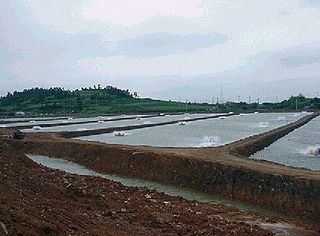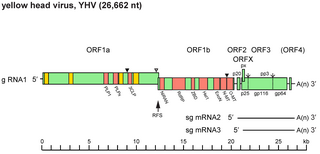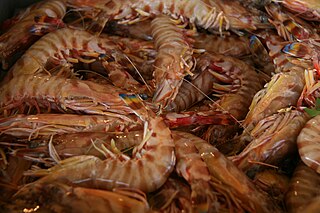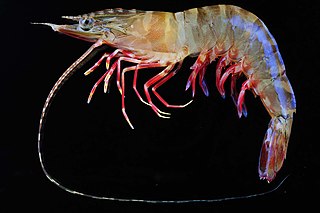
Dendrobranchiata is a suborder of decapods, commonly known as prawns. There are 540 extant species in seven families, and a fossil record extending back to the Devonian. They differ from related animals, such as Caridea and Stenopodidea, by the branching form of the gills and by the fact that they do not brood their eggs, but release them directly into the water. They may reach a length of over 330 millimetres (13 in) and a mass of 450 grams (1.0 lb), and are widely fished and farmed for human consumption.

Whiteleg shrimp, also known as Pacific white shrimp or King prawn, is a species of prawn of the eastern Pacific Ocean commonly caught or farmed for food.

The Indian prawn is one of the major commercial prawn species of the world. It is found in the Indo-West Pacific from eastern and south-eastern Africa, through India, Malaysia and Indonesia to southern China and northern Australia. Adult shrimp grow to a length of about 22 cm (9 in) and live on the seabed to depths of about 90 m (300 ft). The early developmental stages take place in the sea before the larvae move into estuaries. They return to the sea as sub-adults.

Marine shrimp farming is an aquaculture business for the cultivation of marine shrimp or prawns for human consumption. Although traditional shrimp farming has been carried out in Asia for centuries, large-scale commercial shrimp farming began in the 1970s, and production grew steeply, particularly to match the market demands of the United States, Japan and Western Europe. The total global production of farmed shrimp reached more than 1.6 million tonnes in 2003, representing a value of nearly 9 billion U.S. dollars. About 75% of farmed shrimp is produced in Asia, in particular in China and Thailand. The other 25% is produced mainly in Latin America, where Brazil, Ecuador, and Mexico are the largest producers. The largest exporting nation is India.

Yellowhead disease (YHD) is a viral infection of shrimp and prawn, in particular of the giant tiger prawn, one of the two major species of farmed shrimp. The disease is caused by the Yellow head virus genotype 1 (YHV1), a positive-strand RNA virus related to coronaviruses and arteriviruses.

A freshwater prawn farm is an aquaculture business designed to raise and produce freshwater prawns or shrimp for human consumption. Freshwater prawn farming shares many characteristics with, and many of the same problems as, marine shrimp farming. Unique problems are introduced by the developmental life cycle of the main species.
White spot syndrome (WSS) is a viral infection of penaeid shrimp. The disease is highly lethal and contagious, killing shrimp quickly. Outbreaks of this disease have wiped out the entire populations of many shrimp farms within a few days, in places throughout the world.
Taura syndrome (TS) is one of the more devastating diseases affecting the shrimp farming industry worldwide. It was first described in Ecuador during the summer of 1992. In March 1993, it returned as a major epidemic and was the object of extensive media coverage. Retrospective studies have suggested a case of Taura syndrome might have occurred on a shrimp farm in Colombia as early as 1990 and the virus was already present in Ecuador in mid-1991. Between 1992 and 1997, the disease spread to all major regions of the Americas where whiteleg shrimp is cultured. The economic impact of TS in the Americas during that period might have exceeded US$2 billion by some estimates.

Shrimp farming is an aquaculture business that exists in either a marine or freshwater environment, producing shrimp or prawns for human consumption.

Penaeus is a genus of prawns, including the giant tiger prawn, the most important species of farmed crustacean worldwide.

China, with one-fifth of the world's population, accounts for two-thirds of the world's reported aquaculture production.

Penaeus esculentus is a species of prawn which is widely fished for consumption around Australia.

South Korea is a major center of aquaculture production, and the world's third largest producer of farmed algae as of 2020.

A shrimp is a crustacean with an elongated body and a primarily swimming mode of locomotion – typically belonging to the Caridea or Dendrobranchiata of the order Decapoda, although some crustaceans outside of this order are also referred to as "shrimp".

Eyestalk ablation is the removal of one (unilateral) or both (bilateral) eyestalks from a crustacean. It is routinely practiced on female shrimps in almost every marine shrimp maturation or reproduction facility in the world, both research and commercial. The aim of ablation under these circumstances is to stimulate the female shrimp to develop mature ovaries and spawn.
Aquaculture in Madagascar started to take off in the 1980s. The industry includes the cultivation of sea cucumbers, seaweed, fish and shrimp and is being used to stimulate the country's economy, increase the wages of fishermen and women, and improve the regions ocean water quality. Coastal regions of Madagascar are reliant on the Indian Ocean's marine resources as a source of food, income, and cultural identity.
ICAR - Central Institute of Fisheries Education, Rohtak also called as ICAR-CIFE Rohtak is one of the regional research and education campus of the Central Institute of Fisheries Education (CIFE), which is a Deemed to be University and institution of higher learning for fisheries science.

Penaeus semisulcatus, the green tiger prawn or grooved tiger prawn, is a commercially important species of prawn in the genus Penaeus.
Hepatopancreatic parvovirus (HPV) is a group of viruses in the family Parvoviridae with single-stranded DNA containing genomes that infects shrimp, prawn and other crustacean populations. HPV infects the epithelial cells of the host's hepatopancreas and midgut, leading to the stunted growth at the early life stage. For shrimp farms, especially in Asian countries such as China, India and Indonesia, HPV can lead to economic losses in aquaculture due to the reduced production.
















